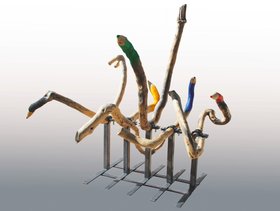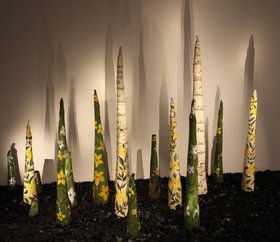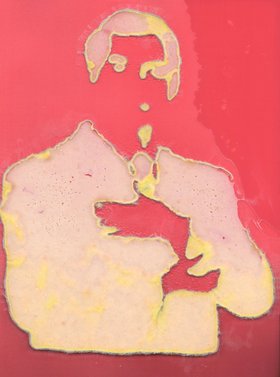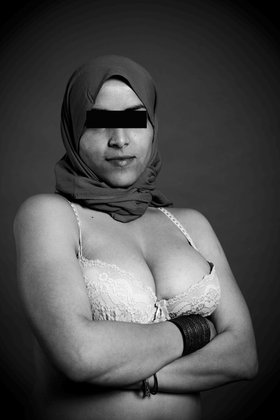Interviews
After the Storm
Michket Krifa in conversation with Wafa Gabsi
One year after the revolution in Tunisia not only ousted a corrupt and corrupting regime but kick-started a wave of revolutions across North Africa and the wider Middle East, an exhibition entitled Dégagements, la Tunisie, Un An Après (Oustings, Tunisia, One Year Later) was staged. Curated by Michket Krifa, and held at the Institut du Monde Arabe in Paris, it showcased the works of some 20 Tunisian artists working in a range of media who witnessed first-hand the revolution as it unfolded. In the this interview with Tunisian writer and curator Wafa Gabsi, Krifa explains how the exhibition came to be and the concerns it expressed, while also discussing the conditions of artistic production in Tunisia today and the problems encountered in staging a show responding to the theme of revolution.
Wafa Gabsi: I am very curious to find out more about your project, the exhibition Dégagements, la Tunisie, Un An Après. How did you get the idea of creating this project? Do you feel there was a sort of urgency, or even necessity which acted as an impulse for the idea of this exhibition?
Michket Krifa: It's been a question of circumstances. I spent the revolution stuck in Paris, I couldn't be part of it because I was in the middle of organizing the Bamako Biennial. I followed the political events on Facebook and of course on television like everyone else, and from these two channels of communication came a huge quantity of images showing what had happened in Tunis. Tunisia is, generally speaking, a country in which you can't take photographs. I have been working with photography for many years and I have long had problems in Tunisia, because photography, be it for documentary, reportage or even fine art purposes, never really developed. There was a real lack of representation. The image didn't exist. And all of a sudden, the image was everywhere, thanks to mobile phones, social networks, computers, the Internet. In parallel with all this was another phenomenon I had never seen before and that was cartoons and drawings in the press invading the Internet. The third phenomenon, aside from virtual space, was that of the public space: finally, the street belonged to the people.
After that, I commissioned the exhibition Enfin Libres (2011), which I produced for an association run by Samir Bouzidi, who asked me if I could help him put on this photography exhibition – the objective being to present what had happened on the street. So I created some narrative panels that leaned toward scenography. I'd actually say that rather than using raw images, they were composed in such a way that each one had a narrative content. It was over two or three days.
Then, there was the Bamako Biennial, and I wanted to pay homage not to the revolution but to the artists. In fact, we kept the work of five Tunisian artists for a pan-African exhibition. What happened beyond the political event was really magnificent. A step was taken, but I wanted to create something for the artists. So, I stood back from it all and engaged an Egyptian and a Tunisian with the production of a DVD capturing videos, photographs, drawings and little animations I had found on Facebook, to get an idea of everything that had taken place around this new creativity. I wanted it to be all about the image, so a bit of distance was needed in the sense that it's a prepared concept, a DVD for each artist, and a narration, but it's not about the event so much as the gaze itself. The two DVDs are wonderful, each lasts 20 minutes, and we presented them at Bamako. At that time, the Institut du Monde Arabe asked me to produce a show for the first anniversary of the revolution. I thought to myself that one must go beyond all these images we've been seeing in the media. What interested me was seeing how an artist can stop and conceptualize at a particular moment in time where history is being written, and that's what happened – that is, there were pieces I knew, artists I had already noted who were responding precisely to this idea, but that there still weren't enough.
WG: So it was a sort of command?
MK: Yes, a command, between what existed and what was very new. What interested me was making a sort of chronology from Mohamed Bouazizi's immolation to just after the elections, and after all these reflections, the questions. This exhibition is a big question mark, it is history in the making but it doesn't affirm anything; rather, it exposes more problems. It is a form of interaction between the developing art world and the form it may take, and the form that this revolution will take in Tunisian society.
WG: So it was a work in progress?
MK: It was rather a pause, a sort of manifesto, because everyone has written something where he or she says here's my position, here's what I believe in, this is why I did it, these are my thoughts at this moment. So it was really an homage to creative liberty.
WG: It's impressive to look at the events as they occurred: on the one hand things happened very quickly, on the other you took a lot of time preparing this project. How do you explain the way the artists adapted to all these events and rapid changes? What informed the choices you made?
MK: Each one took a different angle. I was both inside and outside of it myself – emotionally I am wholly implicated but I am nonetheless outside the country. I have retained and synthesized the information and images that came to me. It's subjective; there is series on regional disequilibrium by Wassim Ghozlani composed of postcards for example; the relationship between the secular and interfaith in Faten Gaddes' work; there are Aicha Filali's bud sculptures (for her the two things that increased as a result of the revolution were freedom of expression and religious sentiment). There is also Héla Lamine and her amateur electorate, which discusses politics in the same way we used to idly gossip; there is Nicène Kossentini whose fragmenting forms, caused either by applause or by military sounds, foresaw the better and worse to come; there is the little resin form by Wissem el Abed that refers to Lampedusa; and Halim Karabibene with her steam cooker alluding to the absence of a museum. They all present questions that artists and people more broadly must ask themselves. To me it seemed important that we take on all these questions together and I privileged different forms of expression: video, photography. Meanwhile, the images of Patricia Triki show two things: how one can protect oneself following the loss of law enforcement and the second, which is more positive, the magnificent solidarity of this revolution. Another example is the series by Jellel Gasteli, who says that he has retained just five images from the revolution, and these kinds of things are beginning to develop in opposition to the exoticism of the revolution. But at the same time there is no place on Earth that doesn't want to celebrate the Arab Spring right now – I think this burst of international solidarity is wonderful.
WG: And what about the adaptation of the different artists to this movement?
MK: It's a question of individual sensibility and I think there was some initial mobilization, for example Aicha Gorgi curated an exhibition on citizenship very quickly, last May or June, in which artists created work specifically for the show, and now there is a moment of pause, to think and to create. There are some pieces that are made on the spot, as a result of a sort of provoked creativity, so I suppose the artist asks himself: What is calling me to this? What do I want to express? I think it's a very personal question. I know artists who have nothing to show because they say they don't have enough distance, and others who say they feel more like citizens now than artists. And then there are others that say they are citizens and artists, and are at the service of each other without quashing one another. It's an exhibition of circumstances, it is not a exhibition of contemporary art in Tunis, it's an exhibition exploring how artists have expressed the revolution and it was also a meeting for three foreign artists; Abdoulaye Konaté, Ali Cherri and Majida Khattari, who were very touched by all this and felt the need to create.
WG: Given the choices you have made in the exhibitions you have curated and particularly from your broad knowledge of photography, I assume you are a good observer of reality. What would you like to show and bring to light through the various pieces you are exhibiting?
MK: It's true that Tunisian contemporary art is less present than others on the international scene and I think this is down to several reasons: the first is the lack of interest from the international community. Tunisia is a beautiful tourist destination but nothing ever really happened there. I curated Femmes d'images in Tunisia in 2007 and things started to move. This was the time to really start following artists, there was material to work with, and after that things developed enormously – in fact these very artists were picked up by galleries, for instance by Galerie el Marsa or Galerie Ammar Farhat. So, you see, there was a desire to show that there was in fact a vibrant Tunisian art scene, and here was the occasion to show it. The second thing is to salute, wholeheartedly, the courage and engagement of the artists as both citizens and creators to affirm their opinions. Finally, I wanted to show that the revolution wasn't just about Bouazizi's immolation and cries of 'dégage, dégage!' ('out, out!'). It's also a thought process, a series of values and choices made by society, and artists are conscious of all of this.
WG: How would do you define Tunisian contemporary art?
MK: I cannot define it and I don't want to generalize. Let's say that generally speaking, it is less picturesque than you find for example in Morocco or Iran. Something that I find very interesting is that artists express themselves outside of the standards or demands of the art market or international curators. Ever since 'Arab' art came onto the world stage, demands were made by biennials and so on, for the most part by curators and market professionals who are westerners and who were looking for a form of visual exoticism. So we very quickly fell into that kind of routine of easy representations; we often find forms such as the female body, the scarf, carpets and so on in works. It is a form of neo-orientalism. Nicène Kossentini's video, though, is not gratuitous, it has meaning. When she borrows the visual effects of Islamic ornament, it's because she is playing with a fragmented visual that has meaning, and because that visual has an Arab-Islamic connotation. It's like several atoms attached to one another. At the end of the video, this is precisely what happens; it fragments, so it does have a meaning and it is not gratuitous.
WG: Are there any specific images that have marked you and which you would like to freeze in time? If so, why is this important to you?
MK: No, I just wanted a new form of open narrative to emerge. These are all artists whose work I like, and whose work has spoken to me. There are certain artists whose work I wanted to show but either I didn't have the chance to or their practices weren't adapted to the subject matter of the exhibition. The selection reflects my opinions, my vision of things, the way I experienced things – we'll have to see what will remain in time. A piece that survives the passing of time is usually a mix of several things: an artist's ability to evolve; the ability of an artist to use the media; and then there is the intrinsic quality of the piece. Through this exhibition I was delighted to work with new talents, such as Héla Lamine, Nidhal Chamekh and Wassim Ghozlani, who I had already recently noted and exhibited. In the space of two years, the scene has really blossomed. I belong to an inhibited generation, scared of creating and of writing, and it took courage to make these choices because creation leads to exhibition, and we are after all in very rigid societies where the exhibition of singularity is complex. Now, for young people, writing, creating and filming are so much easier and I think this desecration and democratization of art is wonderful. We must, however, be careful, because if anyone can be a creator, then new problems can also be created.
WG: What do you think about the term 'revolutionary art', or even 'art of the revolution'?
MK: 'Art of the revolution' – yes, why not? I don't think an artist can be insensitive to what is happening is his environment; we are fed by society, our dreams, our fantasies, if we take all that away, what will the artist feed himself with? We live in a country where everything is political. We are anchored in everything that is social.
WG: So could we deduce that the revolution's relationship to art explains your choice of title for the exhibition?
MK: I didn't choose it and in fact I have reservations about the title. The communications director chose it. I wanted to call it 'De la Révolte au Vote, Transit Tunisia' ('From the Revolt to the Vote, Tunisia Transit'). We have not been in the ousting stage for some time, but rather in the 'engaging' stage. Maybe, as a Tunisian, the perception that we have of this title is very different from that of westerners; we've had enough of the ousting and we want to move on to something else. For them, this word represents the force of the Tunisian revolution. If it was down to me, I would simply have called it 'Tunisia, one year later'; it would have been enough. But the title we ended up with may have attracted more people, a greater French public. Whatever we say and whether we want it or not, we are still caught up in this exoticism in respect of the 'other', particularly now with this revolutionary exoticism. I'd say it's both for the better and for the worse.
WG: How do you define the notion of the engaged artist? Is this engagement beneficial for creativity or should the artist keep a critical distance in order to form a new creative process? Could you explain this using the work of Halim Karabibène and Hichem Driss as examples to show this distance between one piece and another?
MK: I don't want to put them together because we'll inevitably end up comparing them. For example, Hichem Driss's 404 (2010) series denounces censure, the ostracization of people who are outside of the mainstream. There's a very strong side to it; it's like a punch in the face, and all in one photo. Halim Karabibène is an artist who has distanced himself from everything that happened and his work is full of humour, featuring soldiers and little toys in a miniature army. It's a piece bearing a very strong statement, saying that artists are here, they are armed and they must not be ignored.
WG: Don't you think that the artist or even the Tunisian citizen always lays claim to their identity?
MK: For me, my Tunisian identity has never been problematic, I never considered Tunisia to have a problem with its identity. I realized this with the rise of Islamism. The problem is elsewhere, it is an economic one. And if we come back to the issue of identity or of language, I know that during the 1980s, when we tried to Arab-icize society, it didn't work. But what I can add is that Tunisian artists are slightly cut off from the rest of the region's art scene. But Tunisians are proud to be Arab, Mediterranean and African and so on. We were all brought up in that.
WG: In an interview given to the magazine Le Point, Jellel Gasteli declared 'The sudden opportunism of a new generation of icon creators of revolutionary exoticism'. What do you make of it?
MK: I don't think it's anything to worry about; if artists weren't engaged before and are now, it doesn't matter. If the Tunisian bourgeoisie kept quiet all these years and is now becoming militant, what of it? Where is the harm?
WG: But do you not see this phrase from another angle, in the sense that actors on the art scene can profit from the revolution to create events? Isn't it all too easy?
MK: Why not, if these events have a meaning and some content, why not create them? Even if they don't, we need to help them out of all this, things need to be said, the more the better. Afterwards, things will be sifted out and the more structured and talented responses will remain. I often visit average exhibitions but amongst it all you can find someone that stands out. This is how I discovered the artist Mouna Jmal, at the annual exhibition of the union of fine artists. I think artists need to be stimulated and managed. Today, in any case, in the field of contemporary art, artists are very structured intellectually. I have often come across artists who do things instinctively. I am very receptive to this. For me, art is an emotion before being a thought process; it has to touch me before it makes me think.
WG: Where do you situate the lines which separate public space and private space with regards to the representation of political art?
MK: I don't know how to answer you because I am familiar with and have practiced both. I put together the Palestine exhibition on the Pont des Arts in Paris, which was a public event. It was barely announced as an exhibition, because instead of presenting large images, I showed pieces in display cabinets. We didn't want to assault passersby but rather allow them to discover Palestinian everyday life; I wanted them to lean over the work themselves. And then there was also the exhibition about Tunisia on the forecourt of the Town Hall. When we find ourselves in public space, even in a place in which people are only passing, we must respect the place and not impose anything on anyone, so that they want to go towards the piece themselves, or otherwise make the piece be an integral part of the public space, like in a park or a garden. In any case, in the exhibitions I have curated, I tried not to be invasive because the subjects were delicate ones.
As for the exhibition I curated at the Institut du Monde Arab, it is not only of a political nature. It also has a historic side, it is more of a witness statement, even if it does also have a manifesto, and this in itself is part of the historical process. But in the end, it all depends on what you do with it. If an institution, for instance, uses an exhibition for political purposes – that is serious. Because there are several thematic exhibitions that don't necessarily have an active, engaged approach, and that's something quite different. For example, if I go to see an exhibition about Berlin in the 1950s, during which time artists were very engaged politically, that's fine, I don't have a problem with that. In any case, I work with artists, hand-in-hand; we choose the approach, the work, the formats. It is a joint effort, a construction, collaboration, a harmony.



















